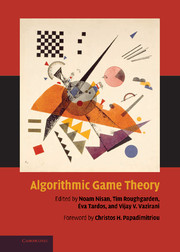Book contents
- Frontmatter
- Contents
- Foreword
- Preface
- Contributors
- I Computing in Games
- II Algorithmic Mechanism Design
- 9 Introduction to Mechanism Design (for Computer Scientists)
- 10 Mechanism Design without Money
- 11 Combinatorial Auctions
- 12 Computationally Efficient Approximation Mechanisms
- 13 Profit Maximization in Mechanism Design
- 14 Distributed Algorithmic Mechanism Design
- 15 Cost Sharing
- 16 Online Mechanisms
- III Quantifying the Inefficiency of Equilibria
- IV Additional Topics
- Index
13 - Profit Maximization in Mechanism Design
from II - Algorithmic Mechanism Design
Published online by Cambridge University Press: 31 January 2011
- Frontmatter
- Contents
- Foreword
- Preface
- Contributors
- I Computing in Games
- II Algorithmic Mechanism Design
- 9 Introduction to Mechanism Design (for Computer Scientists)
- 10 Mechanism Design without Money
- 11 Combinatorial Auctions
- 12 Computationally Efficient Approximation Mechanisms
- 13 Profit Maximization in Mechanism Design
- 14 Distributed Algorithmic Mechanism Design
- 15 Cost Sharing
- 16 Online Mechanisms
- III Quantifying the Inefficiency of Equilibria
- IV Additional Topics
- Index
Summary
Abstract
We give an introduction to the design of mechanisms for profit maximization with a focus on single parameter settings.
Introduction
In previous chapters, we have studied the design of truthful mechanisms that implement social choice functions, such as social welfare maximization. Another fundamental objective, and the focus of this chapter, is the design of mechanisms in which the goal of the mechanism designer is profit maximization. In economics, this topic is referred to as optimal mechanism design.
Our focus will be on the design of profit-maximizing auctions in settings in which an auctioneer is selling (respectively, buying) a set of goods/services. Formally, there are n agents, each of whom desires some particular service. We assume that agents are single-parameter; i.e., agent i's valuation for receiving service is vi and their valuation for no service is normalized to zero. A mechanism takes as input sealed bids from the agents, where agent i's bid bi represents his valuation vi, and computes an outcome consisting of an allocation x = (x1, …, xn) and prices p = (p1, …, pn). Setting xi = 1 represents agent i being allocated service whereas xi = 0 is for no service, and pi is the amount agent i is required to pay the auctioneer. We assume that agents have quasi-linear utility expressed by ui = vixi – pi.
- Type
- Chapter
- Information
- Algorithmic Game Theory , pp. 331 - 362Publisher: Cambridge University PressPrint publication year: 2007
- 31
- Cited by



